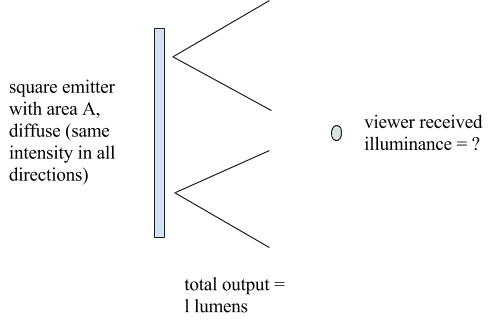Therapeutic light boxes purport to deliver 10,000 lux to a user, typically sitting ~24" from a box. I was wondering how many lumens are necessary to achieve this illuminance, e.g. what lamps would be necessary to build such a box.
Suppose the light box has a flat, square diffuser, where the square has a total area $A$. The box emits a total of $l$ lumens. Given the distance $d$ to the light source, can we have a formula for the illuminance received by a viewer centered in front of the light box, facing it directly?
Here's my thinking so far, by referring to Photometric quantities and this handbook. It doesn't quite seem to work.
We need to first determine the luminance $L$ of the box diffuser's surface (lm/m^2/sr). It has a luminous exitance of $l / A$ (lm/m^2). Apparently for a Lambertian (diffuse) surface, we should divide by $\pi$ to get luminance: $L = l / A / \pi$ (lm/m^2/sr).
Multiplying this luminance by the area $A$ of the box, it has a luminous intensity of $L \cdot A = l / \pi$ (lm/sr). The box is viewed from distance $d$ away, so its apparent size will be approximately(1) $A / (4 \pi d^2)$ steradians. Multiplying luminous intensity by solid angle, the viewer receives $l/\pi \cdot A / (4 \pi d^2)$ (lm).
But wait -- the units seem wrong now. I should have gotten lm/m^2 (lux), not lumens. A single point only receives an infinitesimal amount of lumens. Where did this go wrong?
(1) In reality, the corners of the boxes are farther, so it appears a smaller area. I wonder how much effect this has.
